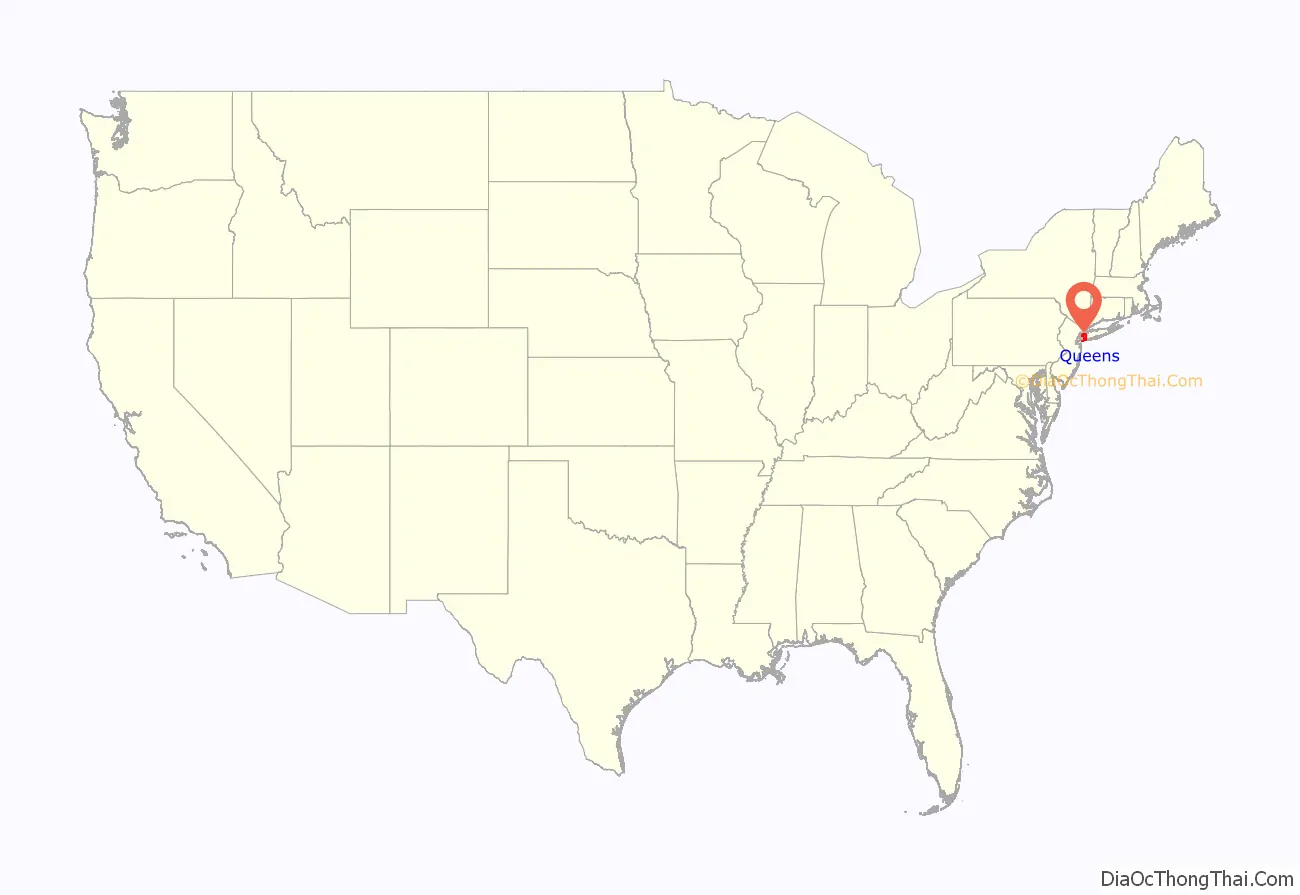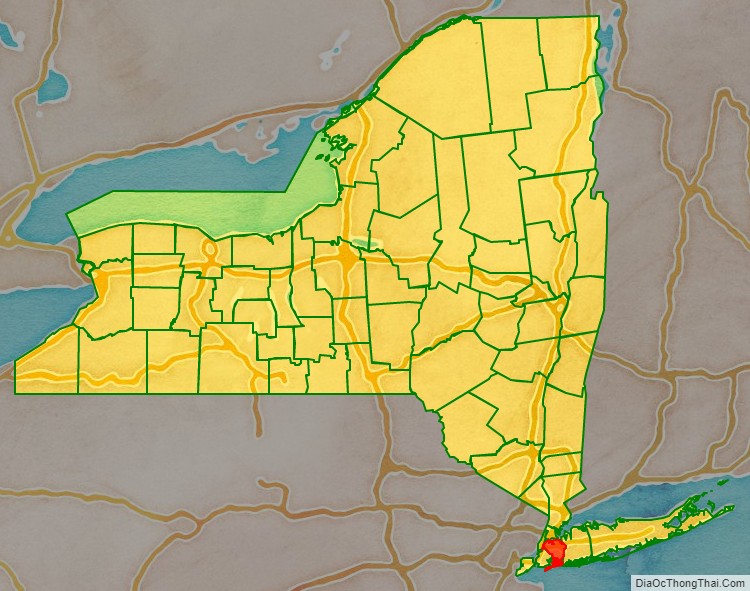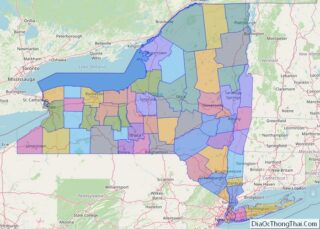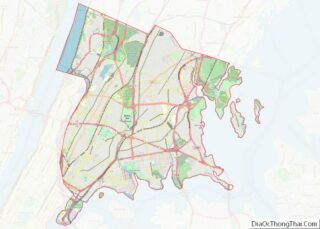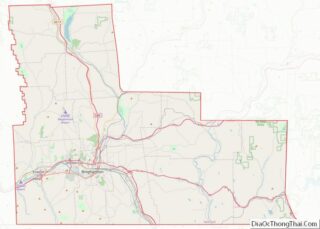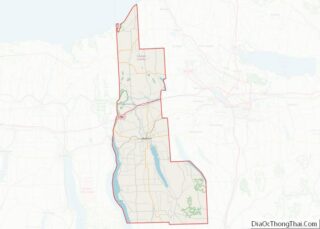Queens is a borough of New York City, coextensive with Queens County, in the U.S. state of New York. Located on Long Island, it is the largest New York City borough by area. It is bordered by the borough of Brooklyn at the western tip of Long Island, and Nassau County to its east. Queens shares water borders with the boroughs of Manhattan, the Bronx, and Staten Island.
With a population of 2,405,464 as of the 2020 census, Queens is the second-most populous county in New York state, behind Kings County (Brooklyn), and is therefore also the second-most populous of the five New York City boroughs. If Queens were a city, it would be the fourth most-populous in the U.S. after New York City, Los Angeles, and Chicago. Queens is the fourth-most densely populated borough in New York City and the fourth-most densely populated U.S. county. About 47% of its residents are foreign-born. Queens is the most linguistically diverse place on Earth and is one of the most ethnically diverse counties in the United States.
Queens was established in 1683 as one of the original 12 counties of the Province of New York. The settlement was named after the English Queen and Portuguese royal princess Catherine of Braganza (1638–1705). From 1683 to 1899, the County of Queens included what is now Nassau County. Queens became a borough during the consolidation of New York City in 1898, combining the towns of Long Island City, Newtown, Flushing, Jamaica, and western Hempstead. All except Hempstead are today considered neighborhoods of Queens.
Queens has the most diversified economy of the five boroughs of New York City. It is home to both of New York City’s airports: John F. Kennedy and LaGuardia. Among its landmarks are Flushing Meadows–Corona Park; Citi Field, home to the New York Mets baseball team; the USTA Billie Jean King National Tennis Center, site of the U.S. Open tennis tournament; Kaufman Astoria Studios; Silvercup Studios; and the Aqueduct Racetrack. Flushing is undergoing rapid gentrification with investment by Chinese transnational entities, while Long Island City is undergoing gentrification secondary to its proximity across the East River from Manhattan.
The borough’s diverse housing ranges from high-rise apartment buildings in some areas of western and central Queens, such as Ozone Park, Jackson Heights, Flushing, Astoria, and Long Island City; to lower-rise neighborhoods in the eastern part of the borough.
| Name: | Queens County |
|---|---|
| FIPS code: | 36-081 |
| State: | New York |
| Founded: | 1683 |
| Named for: | Catherine of Braganza |
| Seat: | none (sui generis) |
| Total Area: | 178 sq mi (460 km²) |
| Land Area: | 109 sq mi (280 km²) |
| Total Population: | 2,405,464 |
| Population Density: | 22,124.5/sq mi (8,542.3/km²) |
| Website: | Official Website of the Queens Borough President |
Queens County location map. Where is Queens County?
History
Colonial and post-colonial history
The first European settlement in the region were the Dutch, who established the colony of New Netherland. The first settlements were established in 1635 followed by further settlement at Maspeth in 1642 (ultimately unsuccessful), and Vlissingen (now Flushing) in 1645. Other early settlements included Newtown (now Elmhurst) in 1652 and Jamaica in 1655. However, these towns were mostly inhabited by English settlers from New England via eastern Long Island (Suffolk County) who were subject to Dutch law. After the capture of the colony by the English and its subsequent renaming as New York in 1664, the area (and all of Long Island) became known as Yorkshire.
The Flushing Remonstrance signed by colonists in 1657 is considered a precursor to the United States Constitution’s provision on freedom of religion in the Bill of Rights. The signers protested the Dutch colonial authorities’ persecution of Quakers in what is today the borough of Queens.
Originally, Queens County included the adjacent area now comprising Nassau County. It was an original county of New York State, one of twelve created on November 1, 1683. The county is presumed to have been named after Catherine of Braganza, since she was queen of England at the time (she was Portugal’s royal princess Catarina, daughter of King John IV of Portugal). The county was founded alongside Kings County (Brooklyn, which was named after her husband, King Charles II), and Richmond County (Staten Island, named after his illegitimate son, the 1st Duke of Richmond). However, the namesake is disputed. While Catherine’s title seems the most likely namesake, no historical evidence of official declaration has been found. On October 7, 1691, all counties in the Colony of New York were redefined. Queens gained North and South Brother Islands as well as Huletts Island (today known as Rikers Island). On December 3, 1768, Queens gained other islands in Long Island Sound that were not already assigned to a county but that did not abut on Westchester County (today’s Bronx County).
Queens played a minor role in the American Revolution, as compared to Brooklyn, where the Battle of Long Island was largely fought. Queens, like the rest of what became New York City and Long Island, remained under British occupation after the Battle of Long Island in 1776 and was occupied throughout most of the rest of the Revolutionary War. Under the Quartering Act, British soldiers used, as barracks, the public inns and uninhabited buildings belonging to Queens residents. Even though many residents opposed unannounced quartering, they supported the British crown. The quartering of soldiers in private homes, except in times of war, was banned by the Third Amendment to the United States Constitution. Nathan Hale was captured by the British on the shore of Flushing Bay and hanged in Manhattan.
From 1683 until 1784, Queens County consisted of five towns: Flushing, Hempstead, Jamaica, Newtown, and Oyster Bay. On April 6, 1784, a sixth town, the Town of North Hempstead, was formed through secession by the northern portions of the Town of Hempstead. The seat of the county government was located first in Jamaica, but the courthouse was torn down by the British during the American Revolution to use the materials to build barracks. After the war, various buildings in Jamaica temporarily served as courthouse and jail until a new building was erected about 1787 (and later completed) in an area near Mineola (now in Nassau County) known then as Clowesville.
The 1850 United States census was the first in which the population of the three western towns exceeded that of the three eastern towns that are now part of Nassau County. Concerns were raised about the condition and distance of the old courthouse, and several sites were in contention for the construction of a new one.
In 1870, Long Island City split from the Town of Newtown, incorporating itself as a city, consisting of what had been the village of Astoria and some unincorporated areas within the town of Newtown. Around 1874, the seat of county government was moved to Long Island City from Mineola.
On March 1, 1860, the eastern border between Queens County (later Nassau County) and Suffolk County was redefined with no discernible change. On June 8, 1881, North Brother Island was transferred to New York County. On May 8, 1884, Rikers Island was transferred to New York County.
In 1886, Lloyd’s Neck, which was then part of the town of Oyster Bay and had earlier been known as Queens Village, was set off and separated from Queens County and annexed to the town of Huntington in Suffolk County. On April 16, 1964, South Brother Island was transferred to Bronx County.
Incorporation as borough
The New York City borough of Queens was authorized on May 4, 1897, by a vote of the New York State Legislature after an 1894 referendum on consolidation. The eastern 280 square miles (730 km) of Queens that became Nassau County was partitioned on January 1, 1899. Queens Borough was established on January 1, 1898.
“The city of Long Island City, the towns of Newtown, Flushing and Jamaica, and that part of the town of Hempstead, in the county of Queens, which is westerly of a straight line drawn through the middle of the channel between Rockaway Beach and Shelter Island, in the county of Queens, to the Atlantic Ocean” was annexed to New York City, dissolving all former municipal governments (Long Island City, the county government, all towns, and all villages) within the new borough. The areas of Queens County that were not part of the consolidation plan, consisting of the towns of North Hempstead and Oyster Bay, and the major remaining portion of the Town of Hempstead, remained part of Queens County until they seceded to form the new Nassau County on January 1, 1899. At this point, the boundaries of Queens County and the Borough of Queens became coterminous. With consolidation, Jamaica once again became the county seat, though county offices now extend to nearby Kew Gardens also.
In 1899, New York City conducted a land survey to determine the exact border of Queens between the Rockaways and Lawrence. This proved difficult because the border was defined as “middle of the channel between Rockaway Beach and Shelter Island” (now called Long Beach Island), and that particular channel had closed up by 1899. The surveyors had to determine where the channel had been when the consolidation law was written in 1894. The surveyors did so in part by speaking with local fishermen and oystermen who knew the area well.
From 1905 to 1908 the Long Island Rail Road in Queens became electrified. Transportation to and from Manhattan, previously by ferry or via bridges in Brooklyn, opened up with the Queensboro Bridge finished in 1909, and with railway tunnels under the East River in 1910. From 1915 onward, much of Queens was connected to the New York City Subway system. With the 1915 construction of the Steinway Tunnel carrying the IRT Flushing Line between Queens and Manhattan, and the robust expansion of the use of the automobile, the population of Queens more than doubled in the 1920s, from 469,042 in 1920 to 1,079,129 in 1930.
In later years, Queens was the site of the 1939 New York World’s Fair and the 1964 New York World’s Fair. LaGuardia Airport, in northern Queens, opened in 1939. Idlewild Airport, in southern Queens and now called JFK Airport, opened in 1948. In one of several notable incidents, TWA Flight 800 took off from the airport on July 17, 1996. In another, American Airlines Flight 587 took off from the latter airport on November 12, 2001, but ended up crashing in Queens’ Belle Harbor area, killing 265 people. In late October 2012, much of Queens’ Breezy Point area was destroyed by a massive six-alarm fire caused by Hurricane Sandy.
Queens County Road Map
Geography
Queens is located on the far western portion of geographic Long Island and includes a few smaller islands, most of which are in Jamaica Bay, forming part of the Gateway National Recreation Area, which in turn is one of the National Parks of New York Harbor. According to the United States Census Bureau, Queens County has a total area of 178 square miles (460 km), of which 109 square miles (280 km) is land and 70 square miles (180 km) (39%) is water.
Brooklyn, the only other New York City borough on Long Island, lies just south and west of Queens, with Newtown Creek, an estuary that flows into the East River, forming part of the border. To the west and north is the East River, across which is Manhattan to the west and The Bronx to the north. Nassau County is east of Queens on Long Island. Staten Island is southwest of Brooklyn, and shares only a three-mile-long water border (in the Outer Bay) with Queens. North of Queens are Flushing Bay and the Flushing River, connecting to the East River. The East River opens into Long Island Sound. The midsection of Queens is crossed by the Long Island straddling terminal moraine created by the Wisconsin Glacier. The Rockaway Peninsula, the southernmost part of all of Queens, sits between Jamaica Bay and the Atlantic Ocean, featuring 7 miles (11 km) of beaches.
Climate
Under the Köppen climate classification, using the 32 °F (0 °C) coldest month (January) isotherm, Queens and the rest of New York City have a humid continental climate (Dfa) bordering humid subtropical climate (Cfa) with partial shielding from the Appalachian Mountains and moderating influences from the Atlantic Ocean. Queens receives precipitation throughout the year, with an average of 44.8 inches (114 cm) per year. In an average year, there will be 44 days with either moderate or heavy rain.
An average winter will have 22 days with some snowfall, of which nine days have at least 1 inch (2.5 cm) of snowfall. Summer is typically hot, humid, and wet. An average year will have 17 days with a high temperature of 90 °F (32 °C) or warmer. In an average year, there are 14 days on which the temperature does not go above 32 °F (0 °C) all day. Spring and autumn can vary from chilly to very warm.
The highest temperature ever recorded at LaGuardia Airport was 107 °F (42 °C) on July 3, 1966. The highest temperature ever recorded at John F. Kennedy International Airport was 104 °F (40 °C), also on July 3, 1966. LaGuardia Airport’s record-low temperature was −7 °F (−22 °C) on February 15, 1943, the effect of which was exacerbated by a shortage of heating oil and coal. John F. Kennedy International Airport’s record-low temperature was −2 °F (−19 °C), on February 8, 1963, and January 21, 1985. On January 24, 2016, 30.5 inches (77 cm) of snow fell, which is the record in Queens.
Tornadoes are generally rare; the most recent tornado, an EF0, touched down in College Point on August 3, 2018, causing minor damage. Before that, there was a tornado in Breezy Point on September 8, 2012, which damaged the roofs of some homes,< and an EF1 tornado in Flushing on September 26, 2010.
